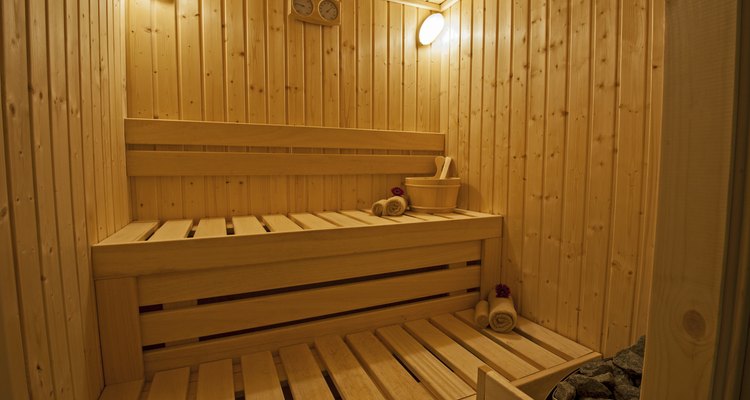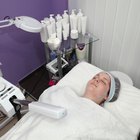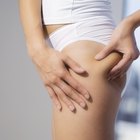
PaulVinten/iStock/Getty Images
Sauna enthusiasts credit their routine use with promoting good health in many ways, including boosting the immune system, relieving pain and muscle aches, reducing inflammation, improving blood circulation and relieving stress. Although there isn't much research linking sauna therapy to healing scar tissue that forms inside or outside the body, a sauna's cardiovascular benefits -- which include increasing the flow of blood, oxygen and nutrients throughout the body -- may have an indirect effect on healing internal and external scars.
Sauna Bathing
Found in most health clubs and fitness centers, a sauna is a small, enclosed room featuring a wooden upper and lower bench along with wooden walls, floor and ceiling. Heated by an electric stove covered with rocks, the temperature inside a sauna may range from 176 degrees F to 194 degrees F. Sauna users can regulate the humidity in the room by pouring water on the stones. Sauna therapy expert Lawrence Wilson says saunas that feature infrared heaters are more effective for healing because infrared heat penetrates the body deeper than heat of a traditional sauna. In Finland, sauna bathing has become a necessity for healing and maintaining good health.
Scar Tissue Formation
As part of its healing process, the body produces fibrous tissues to replace skin damaged after a cut, scrape or burn. External scars also form after a surgery and as the result of skin eruptions that develop with infectious diseases such as chickenpox. Scar tissue is generally raised, thicker and a different color than the rest of your skin. Internal scar tissue forms on muscles, tendons, ligaments, fascia and joints after repetitive motions, injury and surgery as the body develops connective tissue to heal damaged muscles or joints.
Saunas and Blood Circulation
Sitting in a sauna forces your body to perspire, and most people release about a pint of sweat during a 20-minute sauna session. Wilson says saunas enhance your body’s natural method for eliminating wastes through its skin. At the same time, the amount of blood pumped by your heart increases. This increased blood circulation brings more oxygen to injured tissues, cartilage, joints and musculoskeletal areas and decreases inflammation, physician Graham Simpson writes in "Spa Medicine." Increased blood flow rejuvenates the skin, improving skin tone and texture, Wilson says.
Circulation and Scar Tissue
With poor circulation linked to slow healing, improving blood flow may help your body heal faster, internally and externally. However, there isn't a well-documented link between sauna therapy and scar healing. A study published in 2003 found no difference in wound healing among a group of 79 patients after some were encouraged to use a sauna three days after surgery and others were prohibited from sauna bathing. Depending upon the location of your scar tissue, the scar's age, size and the injury that caused scarring, a medical professional likely would provide the best guidance.
Scar Healing Remedies
Generally, the traditional medical community hasn't embraced sauna therapy as a treatment for scars. The National Institutes of Health lists surgical revision, dermabrasion, laser treatments, injections, chemical peels and creams as treatments to minimize external scarring. Anecdotal evidence appears to validate efficacy of some external scar reduction therapies that feature rubbing the skin daily with ointments consisting of vitamin E or essential oils formulated to penetrate the skin, stimulate circulation and encourage growth of new skin cells.
Related Articles

Sauna Cleaning Requirements

Swollen Lymph Nodes in Horses

Facial Steamer Instructions

How to Get Rid of Dark Spots Around a ...

How to Tighten Loose Ligaments

Ionithermie Cellulite Treatment
How to Cook Prime Rib on an Electric ...

Peppermint Oil for Nasal Congestion

Harmful Effects of Wearing Magnetic ...

How to Cook a Goose on the Grill

What Creams Can I Use at Home After ...

How to Deal With a Chapped Nose From ...

Can You Remove Blackheads From the Face ...

Herbs For Saunas

Why Does the Tanning Bed Make You Happy?

What Are the Dangers of Photofacials?

Problems With Nose Piercings

Types of Hotel Rooms

How to Tan Faster in a Tanning Bed

Detox to Reduce Cellulite
References
Resources
Writer Bio
Cassie M. Chew is a multimedia journalist who covers politics, health care, education policy and technology news for print and online newspapers, magazines and trade press journals. When she's not pursuing a story, Chew enjoys independent film, biographies and books about nutrition and health. She holds a Master of Science in journalism from Northwestern University.
Photo Credits
PaulVinten/iStock/Getty Images